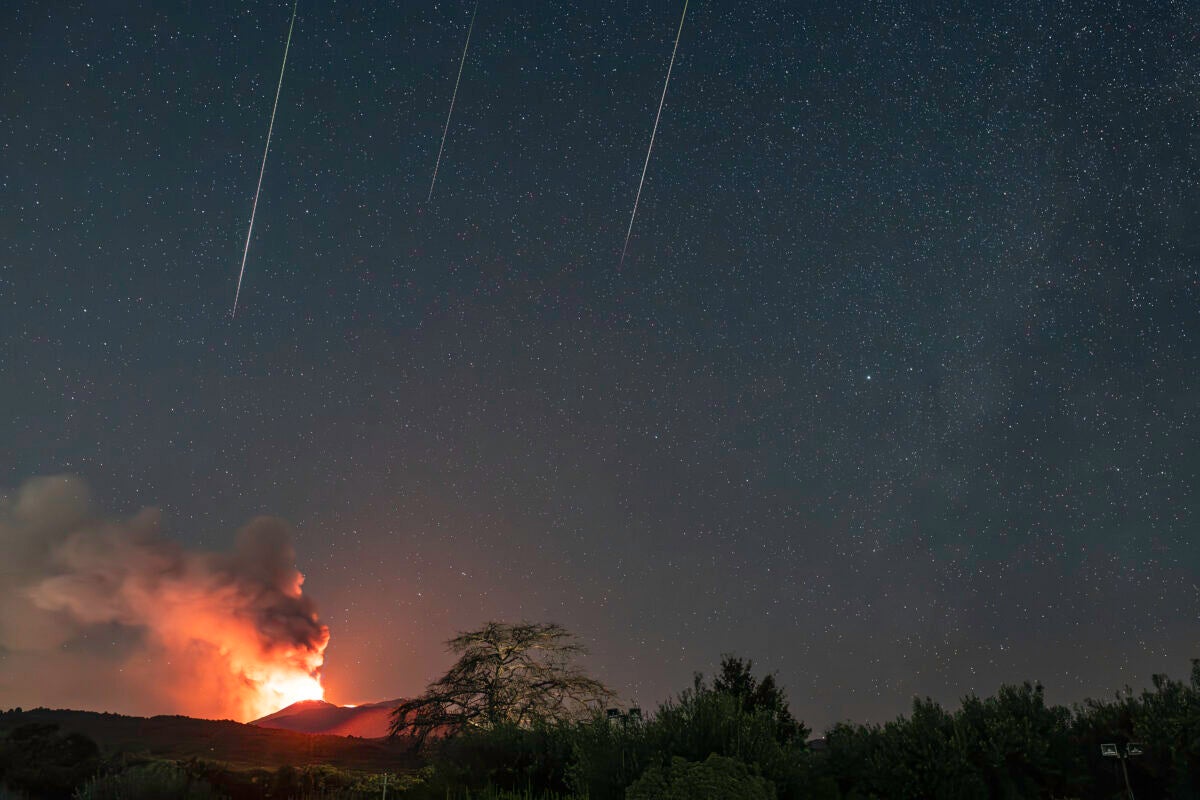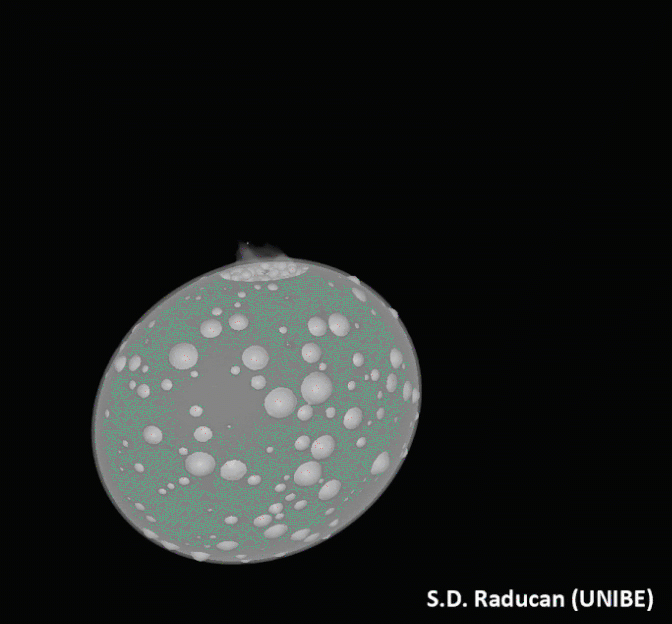
Three Perseid meteors rain down above Mount Etna. A study suggests NASA’s DART mission, which impacted an asteroid, could create a meteor shower, dubbed the Dimorphids. Credit: Gianni Tumino
Come 2034, humans could witness the first-ever artificial meteor shower sparked by activity in space.
That’s according to a new simulation led by Eloy Peña Asensio of Italy’s Polytechnic University of Milan, who modeled the trajectories of 3 million particles of rocky debris blasted into space after NASA’s DART spacecraft intentionally slammed into the diminutive asteroid Dimorphos in 2022.
DART’s crash, which can be likened to a vending machine hitting a football stadium, altered the asteroid’s shape and sent more than 2 million pounds (a million kilograms) of rocks and dust flying into space, thanks to little resistance put forth by Dimorphos’ rubble-pile nature. The ultimate destination of all that debris has been uncertain — until now.
Using data collected by the Italian LICIACube micro-satellite that hitched a ride on DART and recorded the collision and its aftermath, Asensio and his colleagues have now modeled the ejecta’s journey. The researchers grouped the debris into three categories based on their sizes — 4 inches, 0.2 inch, and 0.0012 inch (10 cm, 0.5 cm and 30 micrometers) — and speeds of 2.2 mph up to 4,500 mph (1 meter per second up to 2 kilometers per second).
The researchers estimate some of the high-velocity material will waft in the vicinity of Mars within seven years and create an observable meteor shower. This sprinkle of debris, dubbed the Dimorphids, will result from particles that were launched at speeds of 1,700 mph (770 meters per second), while the slower ones would arrive at the Red Planet a couple years later, according to a new paper by the researchers that has been accepted for publication in The Planetary Science Journal.
A few grams of ultrafast-moving debris particles may also reach Earth in about seven years, but only tiny fragments that were blasted from Dimorphos’ surface at speeds exceeding 3,300 mph (1.5 kilometers per second) have a chance to reach our planet, Asensio says.
“We were amazed to discover that it is possible for some centimeter-sized particles to reach the Earth-Moon system and produce a new meteor shower,” study co-author Josep Trigo-Rodríguez of the Spanish Institute of Space Sciences said in a recent news release. “If this happens, we will witness the first human-made meteor shower,” Asensio added.

The new simulation predicts that debris making its way to Earth will produce luminous streaks possibly visible to the naked eye, predominantly in the Southern Hemisphere. “The potential meteors created by DART would be slow-moving . . . and most likely to occur in May,” study co-author Michael Kueppers of the European Space Agency (ESA) said in the statement.
Asensio says the debris, the largest pieces of which would be the size of a softball, will not pose any meaningful risk to our planet as it will vaporize in the upper atmosphere long before reaching Earth’s surface.
Any incoming debris wouldn’t be of any real threat to satellites orbiting Earth either, experts say. “It’s something you might be able to detect if you really tried, but not something to worry about,” says Jonathan C. McDowell, an astrophysicist at the Center for Astrophysics in Massachusetts.
An internal analysis by the DART mission team concurs, showing there is “no significant debris hazard” to near-Earth orbit, Tom Statler, the program scientist for DART at NASA, told The New York Times.
The fact that the LICIACube probe and various ground-based telescopes were able to watch particles the size of a sand grain blast from Dimorphos’ surface is a testament to the modern technology. Of course, the debris particles wafted far away from the asteroid soon after DART’s impact, and have long drifted out of sight of telescopes.
“They are just diluted in the darkness of space,” says Asensio. “It is impossible to observe them anymore.”
The next opportunity to glimpse the debris is only when it enters the atmospheres of Mars or Earth and produces observable meteors. And while the prospect of gazing at a human-made meteor shower is fascinating in its own right, astronomers are also keen to utilize the rare opportunity to collect scientific data. Such observational data could help them confirm and fine-tune simulations of the ejecta’s dynamics and motion, which could then inform future planetary defense techniques, says Asensio.
Meanwhile Dimorphos and its bigger companion Didymos are scheduled for a robotic visit at the end of 2026 by ESA’s Hera mission. The spacecraft is designed to study how Dimorphos looks post-impact, including its composition, permanently-altered structure, and wobbling profile.
“Everything that we got a good view of from DART either got ejected or pushed aside,” Statler previously told Astronomy. “We may be looking at what for all intents and purposes is a brand-new asteroid to our view.”

